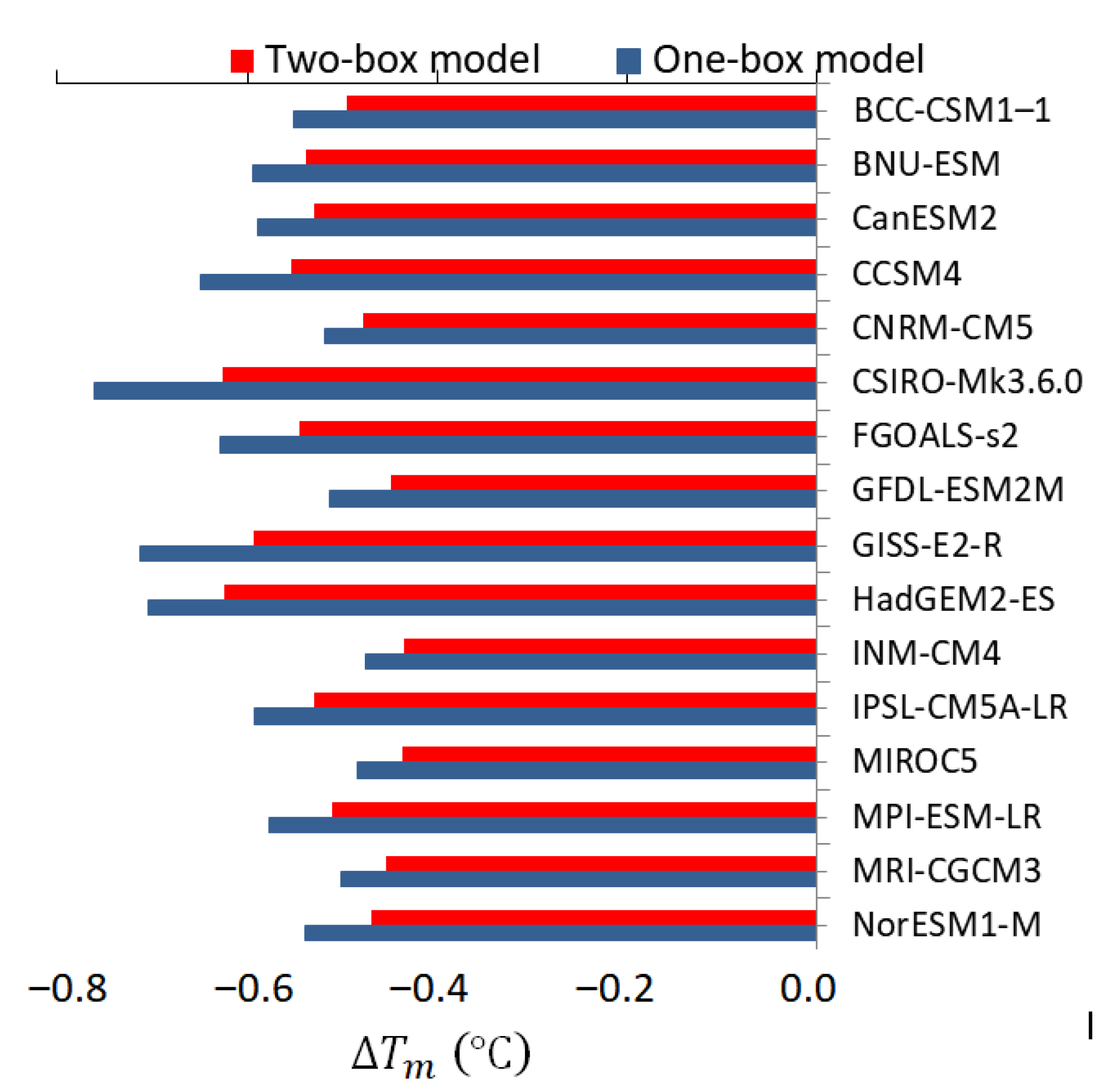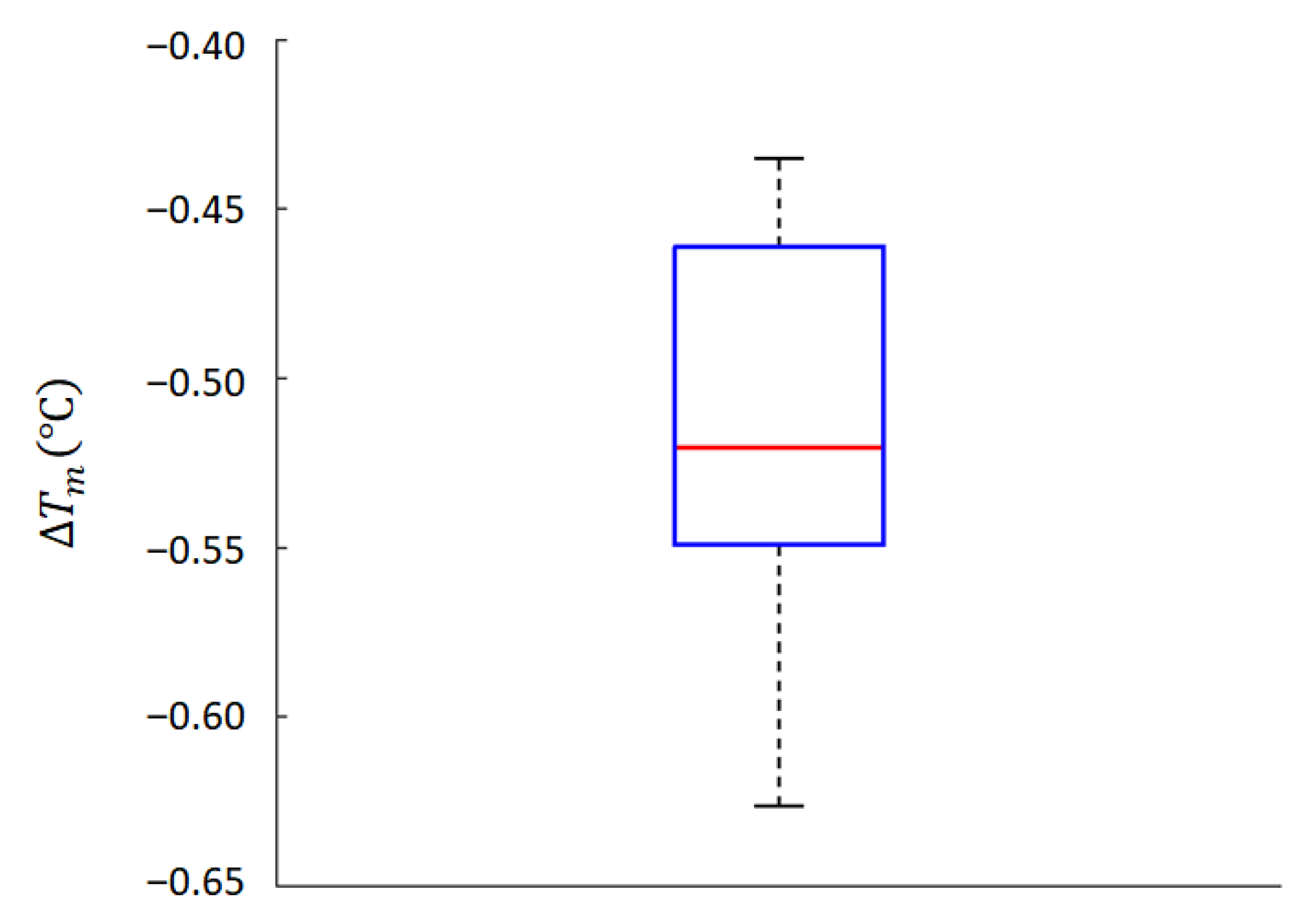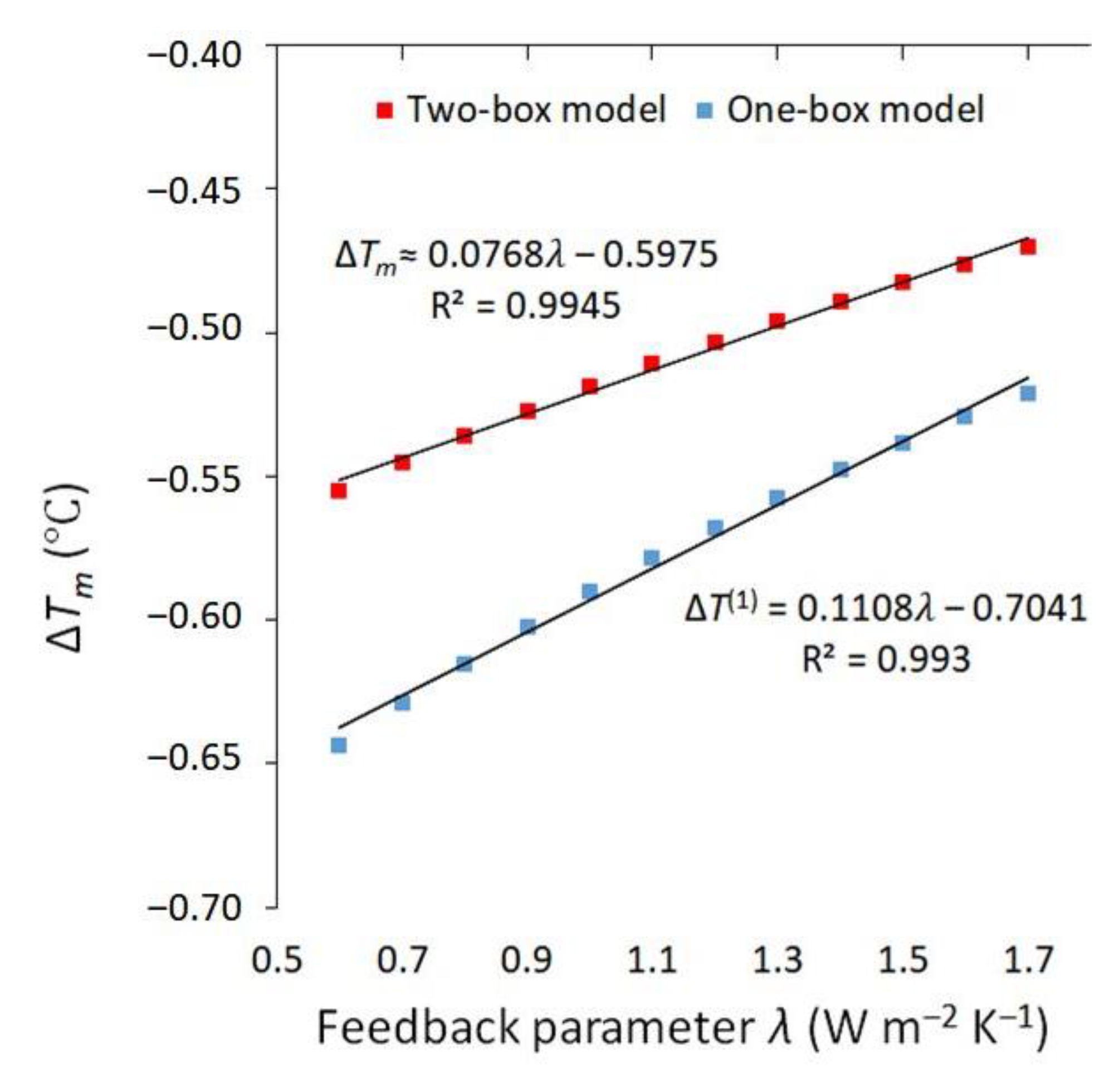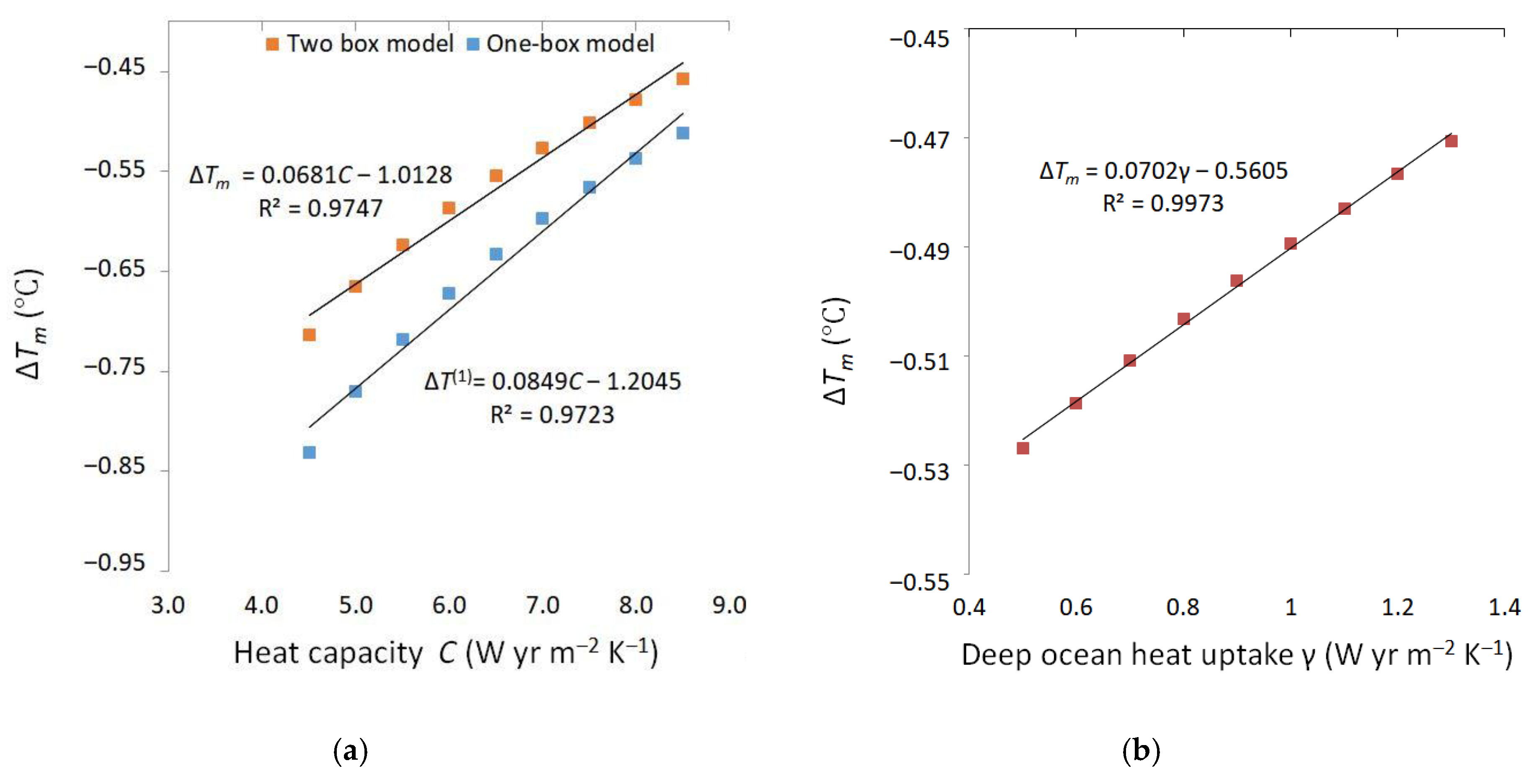Estimating the Effect of Radiative Feedback Uncertainties on Climate Response to Changes in the Concentration of Stratospheric Aerosols
Abstract
1. Introduction
2. Materials and Methods
2.1. The Model
2.2. The Global Radiative Forcing Due to Stratospheric SulfateA
2.3. Technique for the Solution of EBM Equations
3. Results and Discussion
4. Conclusions
Funding
Acknowledgments
Conflicts of Interest
Appendix A
References
- Boucher, O.; Randall, D.; Artaxo, P.; Bretherton, C.; Feingold, G.; Forster, P.; Kerminen, V.-M.; Kondo, Y.; Liao, H.; Lohmann, U.; et al. Clouds and Aerosols. In Climate Change 2013: The Physical Science Basis. Contribution of Working Group I to the Fifth Assessment Report of the Intergovernmental Panel on Climate Change; Stocker, T.F., Qin, D., Plattner, G.-K., Tignor, M., Allen, S.K., Boschung, J., Nauels, A., Xia, Y., Bex, V., Midgley, P.M., Eds.; Cambridge University Press: Cambridge, UK; New York, NY, USA, 2013; pp. 571–657. [Google Scholar]
- Myhre, G.; Shindell, D.; Bréon, F.-M.; Collins, W.; Fuglestvedt, J.; Huang, J.; Koch, D.; Lamarque, J.-F.; Lee, D.; Mendoza, B.; et al. Anthropogenic and natural radiative forcing. In Climate Change 2013: The Physical Science Basis. Contribution of Working Group I to the Fifth Assessment Report of the Intergovernmental Panel on Climate Change; Stocker, T.F., Qin, D., Plattner, G.-K., Tignor, M., Allen, S.K., Boschung, J., Nauels, A., Xia, Y., Bex, V., Midgley, P.M., Eds.; Cambridge University Press: Cambridge, UK; New York, NY, USA, 2013; pp. 659–740. [Google Scholar]
- Matveev, L.T. General Meteorology Course. Atmospheric Physics; Hydrometeorological Publ.: St. Petersburg, Russia, 2000; p. 751. [Google Scholar]
- Hartmann, D.L. Global Physical Climatology. International Geophysics Series, Volume 56; Academic Press: New York, NY, USA, 1994; p. 412. [Google Scholar]
- Boucher, O. Atmospheric Aerosols: Properties and Climate Impacts; Springer: Dordrecht, The Netherlands, 2015; p. 328. [Google Scholar]
- Hansen, J.; Sato, M.; Ruedy, R.; Nazarenko, L.; Lacis, A.; Schmidt, G.A.; Russell, G.; Aleinov, I.; Bauer, M.; Bauer, S.; et al. Efficacy of climate forcing. J. Geophys. Res. 2005, 110, D18104. [Google Scholar] [CrossRef]
- Haywood, J.M. Atmospheric aerosols and their role in climate change. In Climate Change. Observed Impacts on Planet Earth, 2nd ed.; Letcher, T.M., Ed.; Elsevier: New York, NY, USA, 2016; pp. 449–463. [Google Scholar]
- Stenchikov, G.L. The role of volcanic activity in climate and global change. In Climate Change. Observed Impacts on Planet Earth, 2nd ed.; Letcher, T.M., Ed.; Elsevier: New York, NY, USA, 2016; pp. 419–447. [Google Scholar]
- Irvine, P.J.; Kravitz, B.; Lawrence, M.G.; Muri, H. An overview of the Earth system science of solar geoengineering. WIREs Clim. Chang. 2016, 7, 815–833. [Google Scholar] [CrossRef]
- Caldeira, K.; Bala, G. Reflecting on 50 years of geoengineering research. Earth Future 2017, 5, 1–17. [Google Scholar] [CrossRef]
- Soldatenko, S.A. Estimating the impact of artificially injected stratospheric aerosols on the global mean surface temperature in the 21th century. Climate 2018, 6, 85. [Google Scholar] [CrossRef]
- Soldatenko, S.A.; Yusupov, R.M. Optimal control for the process of using artificial sulfate aerosols for mitigating global warming. Atmos. Ocean. Optics 2019, 32, 55–63. [Google Scholar] [CrossRef]
- Meehl, G.A.; Stocker, T.F.; Collins, W.D.; Friedlingstein, P.; Gaye, A.T.; Gregory, J.M.; Kitoh, A.; Knutti, R.; Murphy, J.M.; Noda, A.; et al. Global Climate Projections. In Climate Change 2007: The physical science basis. Contribution of Working Group I to the Fourth Assessment Report of the Intergovernmental Panel on Climate Change; Solomon, S., Qin, D., Manning, M., Chen, Z., Marquis, M., Averyt, K.B., Tignor, M., Miller, H.L., Eds.; Cambridge University Press: Cambridge, UK, 2007; pp. 747–845. [Google Scholar]
- Collins, M.; Knutti, R.; Arblaster, J.; Dufresne, J.-L.; Fichefet, T.; Friedlingstein, P.; Gao, X.; Gutowski, W.J.; Johns, T.; Krinner, G.; et al. Long-term climate change: projections, commitments and irreversibility. In Climate Change 2013: The Physical Science Basis. Contribution of Working Group I to the Fifth Assessment Report of the Intergovernmental Panel on Climate Change; Stocker, T.F., Qin, D., Plattner, G.-K., Tignor, M., Allen, S.K., Boschung, J., Nauels, A., Xia, Y., Bex, V., Midgley, P.M., Eds.; Cambridge University Press: Cambridge, UK; New York, NY, USA, 2013; pp. 1029–1136. [Google Scholar]
- Flato, G.; Marotzke, J.; Abiodun, B.; Braconnot, P.; Chou, S.C.; Collins, W.; Cox, P.; Driouech, F.; Emori, S.; Eyring, V.; et al. Evaluation of Climate Models. In Climate Change 2013: The Physical Science Basis. Contribution of Working Group I to the Fifth Assessment Report of the Intergovernmental Panel on Climate Change; Stocker, T.F., Qin, D., Plattner, G.-K., Tignor, M., Allen, S.K., Boschung, J., Nauels, A., Xia, Y., Bex, V., Midgley, P.M., Eds.; Cambridge University Press: Cambridge, UK; New York, NY, USA, 2013; pp. 741–866. [Google Scholar]
- Bony, S.; Colman, R.A.; Kattsov, V.M.; Allan, R.P.; Bretherton, C.S.; Dufresne, J.-L.; Hall, A.; Hallegatte, S.; Holland, M.M.; Ingram, W.; et al. How well do we understand and evaluate climate change feedback processes? J. Clim. 2006, 19, 3445–3482. [Google Scholar] [CrossRef]
- Zelinka, M.D.; Klein, S.A.; Taylor, K.E.; Andrews, T.; Webb, M.J.; Gregory, J.M.; Forster, P.M. Contributions of different cloud types to feedbacks and rapid adjustments in CMIP5. J. Clim. 2013, 26, 5007–5027. [Google Scholar] [CrossRef]
- Colman, R.A. A comparison of climate feedback in general circulation models. Clim. Dyn. 2003, 20, 865–873. [Google Scholar] [CrossRef]
- Soldatenko, S.; Colman, R. Climate variability from annual to multi-decadal timescales in a two-layer stochastic energy balance model: analytic solutions and implications for general circulation models. Tellus A Dyn. Meteorol. Oceanogr. 2019, 71, 1–15. [Google Scholar] [CrossRef]
- Colman, R.; Soldatenko, S. Understanding the links between climate feedbacks, variability and change using a two-layer energy balance model. Clim. Dyn. 2020, 54, 3441–3459. [Google Scholar] [CrossRef]
- Loeb, N.G.; Su, W.; Kato, S. Understanding climate feedbacks and sensitivity using observations of Earth’s energy budget. Curr. Clim. Chang. Rep. 2016, 2, 170–178. [Google Scholar] [CrossRef] [PubMed]
- Soldatenko, S.A.; Yusupov, R.M. Estimating the influence of thermal inertia and feedbacks in the atmosphere-ocean system on the variability of the global surface air temperature. Atmos. Ocean. Phys. 2019, 55, 591–601. [Google Scholar] [CrossRef]
- Gregory, J.M.; Andrews, T. Variation in climate sensitivity and feedback parameters during the historical period. Geophys. Res. Lett. 2016, 43, 3911–3920. [Google Scholar] [CrossRef]
- Roe, G. Feedbacks, timescales and seeing red. Annu. Rev. Earth Planet. Sci. 2009, 37, 93–115. [Google Scholar] [CrossRef]
- Heinze, C.; Eyring, V.; Friedlingstein, P.; Jones, C.; Balkanski, Y.; Collins, W.; Fichefet, T.; Gao, S.; Hall, A.; Ivanova, D.; et al. ESD Reviews: Climate feedbacks in the Earth system and prospects for their evaluation. Earth Syst. Dyn. 2019, 10, 379–452. [Google Scholar] [CrossRef]
- Gregory, J.M.; Ingram, W.J.; Palmer, M.A.; Jones, G.S.; Stott, P.A.; Thorpe, R.B.; Lowe, J.A.; Johns, T.C.; Williams, K.D. A new method for diagnosing radiative forcing and climate sensitivity. Geophys. Res. Lett. 2004, 31, L03205. [Google Scholar] [CrossRef]
- Gregory, J.M.; Andrews, T.; Ceppi, P.; Mauritsen, T.; Webb, M.J. How accurately can the climate sensitivity to CO2 be estimated from historical climate change? Clim. Dyn. 2020, 54, 129–157. [Google Scholar] [CrossRef]
- Taylor, K.E.; Stouffer, R.J.; Meehl, G.A. An overview of the CMIP5 and the experimental design. Bull. Am. Meteorol. Soc. 2012, 93, 485–498. [Google Scholar] [CrossRef]
- Geoffroy, O.; Saint-Martin, D.; Olivié, D.J.L.; Voldoire, A.; Bellon, G.; Tytéca, S. Transient climate response in a two-layer energy-balance model. Part I: analytical solution and parameter calibration using CMIP5 AOGCM experiments. J. Clim. 2013, 26, 1841–1857. [Google Scholar] [CrossRef]
- Gregory, J.M. Vertical heat transports in the ocean and their effect on time-dependent climate change. Clim. Dyn. 2000, 16, 501–515. [Google Scholar] [CrossRef]
- Held, I.M.; Winton, M.; Takahashi, K.; Delworth, T.; Zeng, F.; Vallis, G.K. Probing the fast and slow components of global warming by returning abruptly to preindustrial forcing. J. Clim. 2010, 23, 2418–2427. [Google Scholar] [CrossRef]
- Hansen, J.; Sato, M.; Ruedy, R.; Lacis, A.; Asamoah, K.; Borenstein, S.; Brown, E.; Cairns, B.; Caliri, G.; Campbell, M.; et al. A Pinatubo climate modelling investigation. In The Mount Pinatubo Eruption Effects on the Atmosphere and Climate; Fiocco, G., Fuà, D., Visconti, G., Eds.; Springer: Berlin/Heidelberg, Germany, 1996; pp. 233–272. [Google Scholar]
- Karper, H.; Engler, H. Mathematics and Climate; SIAM: Philadelphia, PA, USA, 2013; p. 295. [Google Scholar]
- Hansen, J.; Lacis, A.; Rind, D.; Russell, G.; Stone, P.; Fung, I.; Ruedly, R.; Lerner, J. Climate sensitivity: analysis of feedback mechanisms. In Climate Processes and Climate Sensitivity; Hansen, J.E., Takahashi, T., Eds.; American Geophysical Union: Washington, DC, USA, 1984; pp. 130–163. [Google Scholar]
- Paynter, D.; Frölicher, T.L. Sensitivity of radiative forcing, ocean heat uptake, and climate feedback to changes in anthropogenic greenhouse gases and aerosols. J. Geophys. Res. Atmos. 2015, 120, 9837–9854. [Google Scholar] [CrossRef]
- Forcings in GISS Climate Models. Available online: https://data.giss.nasa.gov/modelforce/strataer/#References (accessed on 11 April 2020).
- Stenchikov, G.L.; Kirchner, I.; Robock, A.; Graf, H.-F.; Antuña, J.C.; Grainger, R.G.; Lambert, A.; Thomason, L. Radiative forcing from the 1991 Mount Pinatubo volcanic eruption. J. Geophys. Res. 1998, 103, 13837–13857. [Google Scholar] [CrossRef]
- Timmreck, C.; Mann, G.W.; Aquila, V.; Hommel, R.; Lee, L.A.; Schmidt, A.; Brühl, C.; Carn, S.; Chin, M.; Dhomse, S.S.; et al. The Interactive Stratospheric Aerosol Model Intercomparison Project (ISA-MIP): motivation and experimental design. Geosci. Model Dev. 2018, 11, 2581–2608. [Google Scholar] [CrossRef]
- Attenborough, M. Mathematics for Electrical Engineering and Computing; Elsevier: London, UK, 2003; p. 576. [Google Scholar]
- Soldatenko, S.A.; Yusupov, R.M. Model for estimating the transient response of the global mean surface temperature to changes in the concentrations of atmospheric aerosols and radiatively active gases. Atmos. Ocean. Opt. 2019, 32, 578–585. [Google Scholar] [CrossRef]
- Parker, D.E.; Wilson, H.; Jones, P.D.; Christy, J.R.; Folland, C.K. The impact of Mount Pinatubo on world-wide temperatures. Int. J. Climatol. 1996, 16, 487–497. [Google Scholar] [CrossRef]
- Soldatenko, S.; Steinle, P.; Tingwell, C.; Chichkine, D. Some aspects of sensitivity analysis in variational data assimilation for coupled dynamical systems. Adv. Meteorol. 2015, 2015, 753031. [Google Scholar] [CrossRef]





| Model | Parameter | |||||
|---|---|---|---|---|---|---|
| f | ||||||
| 1 | BCC-CSM1-1 | 7.6 | 53 | 0.67 | 1.21 | 0.64 |
| 2 | BNU-ESM | 7.4 | 90 | 0.53 | 0.93 | 0.72 |
| 3 | CanESM2 | 7.3 | 71 | 0.59 | 1.03 | 0.69 |
| 4 | CCSM4 | 6.1 | 69 | 0.93 | 1.24 | 0.63 |
| 5 | CNRM-CM5 | 8.4 | 99 | 0.50 | 1.11 | 0.67 |
| 6 | CSIRO-Mk3.6.0 | 6.0 | 69 | 0.88 | 0.61 | 0.82 |
| 7 | FGOALS-s2 | 7.0 | 127 | 0.76 | 0.88 | 0.74 |
| 8 | GFDL-ESM2M | 8.1 | 105 | 0.90 | 1.34 | 0.60 |
| 9 | GISS-E2-R | 4.7 | 126 | 1.16 | 1.70 | 0.49 |
| 10 | HadGEM2-ES | 6.5 | 82 | 0.55 | 0.65 | 0.81 |
| 11 | INM-CM4 | 8.6 | 317 | 0.65 | 1.51 | 0.55 |
| 12 | IPSL-CM5A-LR | 7.7 | 95 | 0.59 | 0.79 | 0.76 |
| 13 | MIROC5 | 8.3 | 145 | 0.76 | 1.58 | 0.53 |
| 14 | MPI-ESM-LR | 7.3 | 71 | 0.72 | 1.14 | 0.66 |
| 15 | MRI-CGCM3 | 8.5 | 64 | 0.66 | 1.26 | 0.62 |
| 16 | NorESM1-M | 8.0 | 105 | 0.88 | 1.11 | 0.67 |
| Mean | 7.3 | 106 | 0.73 | 1.13 | 0.66 | |
| STD | 1.1 | 62 | 0.18 | 0.31 | 0.09 | |
| Parameter | ||||
|---|---|---|---|---|
| Parameter uncertainty | ±0.113 | ±0.73 | ±10.60 | ±0.073 |
| (°C) | ±8.68 × 10−3 | ±4.97 × 10−2 | ±2.11 × 10−5 | ±5.12 × 10−3 |
| ±1.68 | ±9.62 | ±0.0041 | ±0.99 |
© 2020 by the author. Licensee MDPI, Basel, Switzerland. This article is an open access article distributed under the terms and conditions of the Creative Commons Attribution (CC BY) license (http://creativecommons.org/licenses/by/4.0/).
Share and Cite
Soldatenko, S. Estimating the Effect of Radiative Feedback Uncertainties on Climate Response to Changes in the Concentration of Stratospheric Aerosols. Atmosphere 2020, 11, 654. https://doi.org/10.3390/atmos11060654
Soldatenko S. Estimating the Effect of Radiative Feedback Uncertainties on Climate Response to Changes in the Concentration of Stratospheric Aerosols. Atmosphere. 2020; 11(6):654. https://doi.org/10.3390/atmos11060654
Chicago/Turabian StyleSoldatenko, Sergei. 2020. "Estimating the Effect of Radiative Feedback Uncertainties on Climate Response to Changes in the Concentration of Stratospheric Aerosols" Atmosphere 11, no. 6: 654. https://doi.org/10.3390/atmos11060654
APA StyleSoldatenko, S. (2020). Estimating the Effect of Radiative Feedback Uncertainties on Climate Response to Changes in the Concentration of Stratospheric Aerosols. Atmosphere, 11(6), 654. https://doi.org/10.3390/atmos11060654





